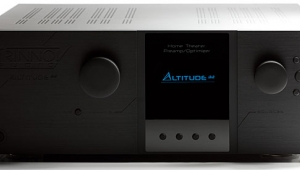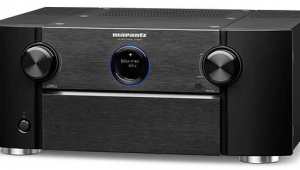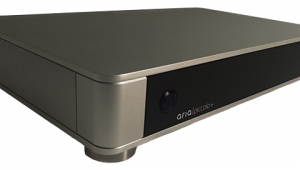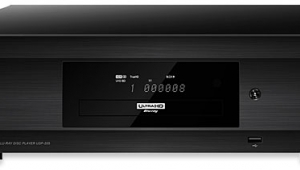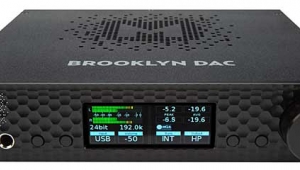| Columns Retired Columns & Blogs |
Music in the Round #11
When I was a young amateur photographer, I subscribed to all the major photo magazines and avidly read all the articles. However, I was bugged when I realized there was a cycle of repetition—that I was reading about the basics of Ansel Adams' Zone System for the third time.
Nowadays, almost all accumulated knowledge, opinions, and mistakes remain accessible on the Web. What's often missing, however, is perspective about what's important and what's not. Newcomers might get the impression that massive breakthroughs are reported in every issue of Stereophile; actually, we spend most of our time splitting hairs. Big improvements happen more often in the source material, loudspeakers, and room acoustics than in amplification and source components. And even electronic devices make more of an imprint on the character of the sound than any competently employed wire. However, every little improvement is valuable; it's just that the assessment of that value is subjective and context-dependent. So, while we eagerly seize on any small improvement, we need to keep their significance in perspective.
Big effects from small changes
In terms of source materials, the big issues are the mixing, balancing, and mastering of the recording, regardless of the number of channels. It's the small adjustments make for success. No one will deny that the same program is significantly different in its subjective effects when presented via different numbers of channels, and that any attentive listener will easily notice that difference. However, the number of channels one prefers is highly dependent on the competence with which the music was recorded and mastered.
For now, let's ignore the straw-man argument based on the abuse of multichannel technology and instead acknowledge that a really good two-channel recording, whether analog or digital, can be holistically satisfying so long as it is low enough in distortion to transmit the essential tonal qualities of the instruments and simulates a realistic frontal soundstage. Years ago, I was swept into my audio addiction by monophonic recordings: Serge Koussevitzky and the Boston Symphony's disc of Sibelius' Symphony 2, Antal Dorati and the Minneapolis Symphony's recording of Tchaikovsky's Sleeping Beauty. These one-channel predecessors of the famous RCA Living Stereo and Mercury Living Presence two-channel LPs still impress me today. On the other hand, skill in the original preparation and the exploitation of modern technologies have come together in the SACD reissues of those classic two-channel releases in the format they were originally recorded in: three channels.
I recently traveled to the Boston suburb of Jamaica Plain to visit Sound/Mirror, where John Newton and his team are transferring the original RCA Living Stereo master tapes onto multichannel SACDs for RCA's parent firm BMG. The impression I'd gained from the general audio press, as well as from documentation from BMG, is that the process is primarily physical: The tapes are handled with care, their ancient splices renewed, the recorded signals then transferred to DSD without tweaking or EQ. If that were so, the team's experience, skill, and taste would be unimportant; all that would need to be done would be a translation from gauss to bits. As it turned out, that wasn't the whole story.
Remastering engineer Mark Donahue was in the process of preparing the second batch of Living Stereo SACDs, and took me on a guided tour of the studios and the process. The layout of the Sound/Mirror facilities concentrates all mechanical devices, including tape decks and hard disks, in a central core that also includes all computers, digital processors, and communications devices. This core is physically and electrically isolated from all the other rooms, but its functions are remote-controllable from all the mastering and monitoring rooms. Donahue can sit in his quiet studio with his B&W 801 monitor loudspeakers and, at the push of a button, A/B a master tape with its DSD translation and/or an SACD checkdisc without the intrusion of any mechanical disturbances.
The process begins with finding and listening to all the tapes from a particular session. But RCA's archive records are inconsistent, and the information written on the tape boxes is often incomplete. And while the ideal is a complete master with minimal splices and a full set of test tones, most masters fall short of this. Before a selected tape can be used, the splices must be repaired with modern materials. Donahue pointed out that while a new, "raw" splice can often be heard, after a few days it becomes inaudible, as if the magnetic particles had healed-over the cut. (He also told me that he can tell when a particular tape was last played by the type of splicing tape used.) He then loads the tape onto a Studer A80 deck, rebuilt with new Aria electronics by ATR, and hunts on the tape for an original set of test tones, which would permit the re-creation of the original tonal balances. Often, however, these tones are missing; Donahue must then find another set of tones, recorded on the same machine at the same session, to use as a guide.
The process of equalizing the playback involves more watching than listening. We stood in the equipment room and intently studied an LED display of a spectral analysis of the signal (resolution to 0.1dB). This is linked to a five-channel Aria equalizer with parametric trim adjustment, which follows passive Ampex Master Equalization (AME). The AME was specifically developed to compensate for the EQ used in the recording of these tapes, as well as for the characteristics of the tape itself—but the original engineers often used different EQ settings; the test tones are the only reliable guide.
Donahue played the tones over and over, tweaking the EQ to get each tone to play back at the same level; the EQ's bands were, of necessity, wide enough to interact. The result was a smooth correction that, despite the time and care involved, never involved an adjustment of more than 0.5dB. He then repeated the process for each of the other two channels.
Having EQ'd the master tape more by eye than by ear, Donahue took me to his den to hear excerpts from the Earl Wild–Arthur Fiedler performance of Gershwin's Rhapsody in Blue. Despite the corrections he'd made, which had seemed quite small, the EQ'd version sounded more dynamic and clear. Wild's piano was primarily in the center channel, but, particularly when heard solo, lacked a little liveliness and impact, which Donahue supplied by boosting the lower midrange a fraction of a dB. He then backed off the center-channel gain another hair's breadth to restore the balance of piano and orchestra.
We could A/B/C/etc. all these subtle adjustments reversibly because they were implemented for monitoring by an analog EQ and the settings stored while the original copy remained untouched. (A good thing, too—this was a dry run performed for my benefit alone.) When optimized, the subtle but essential tweaks are applied via a lossless transfer to a dCS/Pyramix DXD-format intermediary version (24-bit LPCM at 352.8kS/s), and finally to a DSD master stored on hard disk.
Mark Donahue believes that these original RCA Living Stereo master tapes are significantly better than could possibly have been realized on the playback equipment of their time. This few minutes' demonstration—and the final SACD releases—support that belief. We then discussed musicians and recordings we loved and remembered, and I left impressed by Donahue's respect for the artists and engineers who created these recordings.
No EQ? Well, just a fraction of a dB here and there. However, such tiny adjustments can have remarkable results. The original releases sounded great—the new versions let us hear more of what was actually recorded. The subjective effect is decidedly macro. And just as this column was on its way out the modem, I received samples from that new batch of RCA Living Stereo SACDs. See the sidebar, "Recordings in the Round," for my picks of the best three-channel releases.
Big deal about small differences
I reviewed the McCormack UDP-1 universal disc player ($3495) in January, and was stunned when John Atkinson's measurements showed that its digital playback of DVD-Audio and SACD discs was not significantly better than its playback of "Red Book" CDs. In fact, JA told me, the UDP-1's digital performance was not substantially different from that of a $150 Pioneer DV-578A-S universal player he'd bought for reference. But I'd been charmed by the UDP-1's sound, which I'd ascribed to the improved power supply for the audio stages and to McCormack's proprietary analog output stages.

JA's measurements left me questioning my sanity, as well as the relationship of measurements to what one listens for. For instance, when I compared the CD and SACD versions of Andrew Manze's Concertos for the Emperor Vivaldi disc (respectively, Harmonia Mundi HMU 907332 and HMU 807332), I didn't hear more detail in the music, but more space around the music—which may have to do with the amount and frequency distribution of noise in the reproduction. These differences were very subtle, but subtlety is what high-end audio is all about—I'm sure that $150 Pioneer player, when listened to less than critically, could do a similarly satisfying job. The distinctions I drew between the McCormack UDP-1 and two other high-end players, the Denon DV-5900 and Sony XA-9000ES, may be equally tiny. That's not a definitive answer, but one I must live with until I understand more.
I'm now auditioning another high-end player, the Simaudio Moon Orbiter, which, at $7200, costs more than twice as much as the McCormack UDP-1. Immediately, I was impressed with the Orbiter's overall solidity of build when compared with the other players, although its disc drawer's Darth Vaderish heatsink is no fashion statement. Flanking the disc tray and display panel are the standard controls for disc navigation, Video On/Off, Progressive Scan On/Off, and Power/Standby. The rear panel has four digital audio outputs (TosLink, RCA, BNX, XLR), eight analog audio RCA outputs (main L/R, 5.1), four video outputs (composite, S-video, component, DVI), the power switch, power connector, and RS-232 and IR control ports. No surprises.
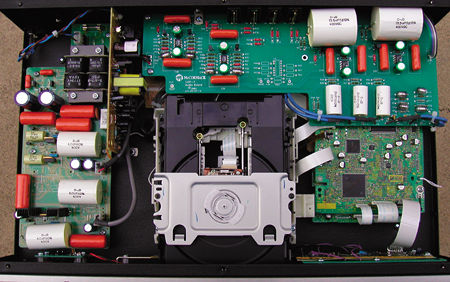
Inside the Orbiter is a lot of circuitry, although much of it is devoted to video functions. These include a Silicon Image SiI504 video scan converter, a standard DVI interface, and an optional SDI output ($1000), none of which the McCormack has. The result is the Orbiter's superior video processing, as assessed with the Silicon Optix test disc. The Orbiter can time-correct for unequal speaker distances, but other than that, its operation is about the same as the McCormack's. And although it's hard to compare specs from two different sources, Simaudio's website quotes wider audio bandwidth and lower distortion than does McCormack's, though both players use 24-bit/192kHz Burr-Brown DACs.
But the main issue is performance, and the Orbiter's is outstanding. I dragged out all my reference recordings—especially those I had in duplicate, so that I could A/B the Orbiter against the other players. Independently, the Orbiter was unaggressive and a bit laid-back. The perceived response was that the midrange was very clear but not excessively prominent. With Andrew Manze's aforementioned Vivaldi CD or SACD, the solo violin seemed a bit small but was in good proportion to the size of the ensemble. With more complex music, transparency and details were outstanding, permitting me to listen into the recordings for individual instruments, even though there was no highlighting. Solo voices were also quite honest and placed just behind the plane of the speakers, along with the rest of the wide, deep soundstage. This self-effacing performance only encouraged me to play the Orbiter at higher levels, at which the sound was louder but with no change in perspective. This seems to me to be evidence of low distortion and a very flat frequency response; otherwise, response peaks and valleys would stick out prominently at higher levels.
But was this performance significantly different from that of the McCormack UDP-1? The showdown was almost too easy. I simply popped identical discs into the two players and, because they share the same remote-control codes, pressed Play on the Orbiter's remote. The chorus on Ubi Caritas, on the DMP sampler (DMP SACD-16), sounded livelier and bigger through the McCormack, but the Orbiter made the acoustic space more distinct, with a greater sense of the spaces between the notes.
- Log in or register to post comments


